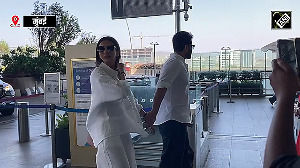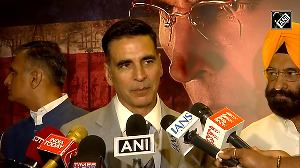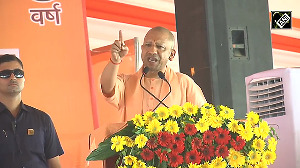The story of Sahara India Pariwar founder Subrata Roy, who died in Mumbai on November 14 aged 75, is the stuff of movies - of a spectacular rise and an equally spectacular fall.

Born in Araria, Bihar, Roy was 30 when he set up Sahara in 1978.
He started with a capital of about Rs 2,000, a peon, a clerk and his father’s Lambretta scooter in Gorakhpur, eastern Uttar Pradesh, writes Tamal Bandyopadhyay in his 2014 book, Sahara: The Untold Story.
Sahara was not his first venture.
Before that, he had “loaded sacks on a truck; supplied stones to the state irrigation department in Gopalganj, Bihar; devised a test for purity of silver and sold electric fans.
"The brand name of the fan was Air Sahara, which later became the name of his aviation venture.
"He had also sold salted snacks, Jaya Products, named after his brother, Joy Broto,” the book notes.
There were other ventures, too, launched after the death of his father, Sudhir Chandra, and with his wife, Swapna Roy.
These also failed to take off.
Roy, who had a diploma in mechanical engineering from a Gorakhpur college, after studying at Holy Child School in Kolkata and CM Anglo Bengali Intermediate College in Varanasi, started small.
But he went on to become the formidable founder of the Sahara India Pariwar, which operated businesses such as Aamby Valley City, Sahara Movie Studios, Air Sahara and Filmy.
His empire spread to cover real estate, finance, media, tourism and hospitality.
The conglomerate’s flagship was Sahara India Financial Corp Ltd, Roy’s para-banking venture where he would sometimes take deposits as low as Rs 1 a day.
The customers included small investors, such as rickshaw-pullers and tea stall owners, who invested money and were promised an assured income in return.
By 2008, in just three decades, Sahara India Financial Corp had become the country’s largest residuary non-banking company, “with a deposit portfolio of Rs 20,000 crore, more than double the deposit base of at least one new private bank, DCB Ltd”, Banyopadhyay writes in his book.
The giant footprint
At its peak, the group had its fingers in many pies. The company owned a wide media network.
The media arm, Sahara One Media and Entertainment, operated three Hindi-language channels, a movie channel (Filmy), and a general entertainment channel (Sahara One).
Many would remember the anchors appearing on screen in uniform and greeting the viewers with a “Sahara pranam”, a hand to their heart. Roy was a man for optics.
Sahara Movie Studios co-produced several big hits (Wanted, Sarkar, Page 3 and Corporate), many of which starred A-listers like Amitabh Bachchan and Salman Khan.
In addition to its distribution business, the group owned newspapers and magazines in Hindi, English and Urdu.
The group also owned a full-scaled commercial airline, Air Sahara, which was sold to Jet Airways in 2006 for over $500 million.
It also had acquisitions in the luxury hospitality segment, including New York’s Plaza Hotel and London’s Grosvenor House Hotel.
That wasn’t all. If films were covered, could cricket be ignored?
Under the flamboyant Roy, the Sahara Group sponsored the Indian cricket team until 2013. In 2010, it bought the Pune franchise of the Indian Premier League for $370 million, the highest bid by any company in the league’s history to date.
Their run lasted until 2018 when the group announced to pull out of the franchise.
In sports, the business house also sponsored the Indian hockey team and owned a stake in another flamboyant tycoon Vijay Mallya’s Formula One racing team.
Roy’s name became synonymous with luxury.
His 270-acre gated residence, “Sahara Shaher” in Lucknow, hosted grand events, with politicians, corporate honchos and movie stars as guests.
The Roy mansion was in the limelight in 2004 when he married his two sons there. India had not seen a wedding of such scale.
Some 10,500 guests were flown in.
The list included India’s who’s who. And who filmed the wedding? Raj Kumar Santoshi.
Then came the speed-breaker
Although the company had run into several financial troubles in the 1990s, the major hiccup came in 2009 when its arm, Sahara Prime City, filed its draft red herring prospectus (DRHP) with the Securities and Exchange Board of India (Sebi) for an initial public offering (IPO).
Disclosures made in the DRHP showed two group firms, Sahara India Real Estate Corporation (SIRECL) and Sahara Housing Investment Corporation (SHICL), had raised money from millions of investors via optionally fully convertible debentures, which was in contravention of the provisions of the Sebi Act.
A routine inquiry launched into the group snowballed into a mega investigation.
It eventually led to the collapse of what turned out to be a house of cards.
In 2011, Sebi passed orders against SIRECL and SHICL, asking them to refund Rs 24,000 crore to over 30 million individuals. The Supreme Court upheld the orders in 2012.
Furthermore, in 2008, the Reserve Bank of India had asked the group to stop accepting more deposits from the public.
At that point, it had deposits of over Rs 20,000 crore.
On further investigation, Sebi barred Sahara Prime City from raising money from the public.
The group’s money was apparently being used to develop 10,600 acres of the Aamby Valley luxury township in Maharashtra.
It also had Sahara City and Sahara Grace townships across several cities in the country.
The group responded by publishing advertisements branding Sebi as “irresponsible”. Upon Sebi’s inquiry, the group sent 127 trucks to the regulator.
The trucks were loaded with over 30 million application forms. Roy enjoyed histrionics.
Sebi revealed that many investors were untraceable.
The case went to the Supreme Court.
End of the road
In 2014, the Supreme Court ordered the company to return all money to the depositors with an interest of 15 per cent.
Roy was jailed until 2016, when he was released on parole.
Later, he was sent back to jail, and then again given parole.
Most properties were attached by the Income Tax department.
In 2018, Sebi passed another order directing Sahara India Commercial Corporation to return Rs 14,100 crore, along with 15 per cent interest, raised between 1998 and 2009 from nearly 20 million investors.
In 2020, acting on Sebi’s petition, the apex court said it would cancel Roy’s parole if the group did not return Rs 62,600 crore to investors (including interest and fines).
The Sahara group had deposited over Rs 15,000 crore with Sebi.
This amount was to be distributed to Sahara investors. However, it remains a mystery why only a few investors came forward to stake claim on these funds.
As on March 31, 2023, Sebi had received 19,650 applications involving 53,687 accounts.
Refunds have been made with respect to 17,526 applications involving 48,326 accounts for an aggregate of Rs 138.07 crore, including the interest amount of Rs 67.98 crore, stated the Sebi’s latest annual report for the 2022-23.
In 2023, the Centre also launched a Sahara Refund Portal where depositors could claim their refund in 45 days.
With Subrata Roy’s death, a chapter of financial violations — described by many as one of India’s biggest Ponzi schemes — comes to an end.
Samie Modak contributed to this report












 © 2025
© 2025